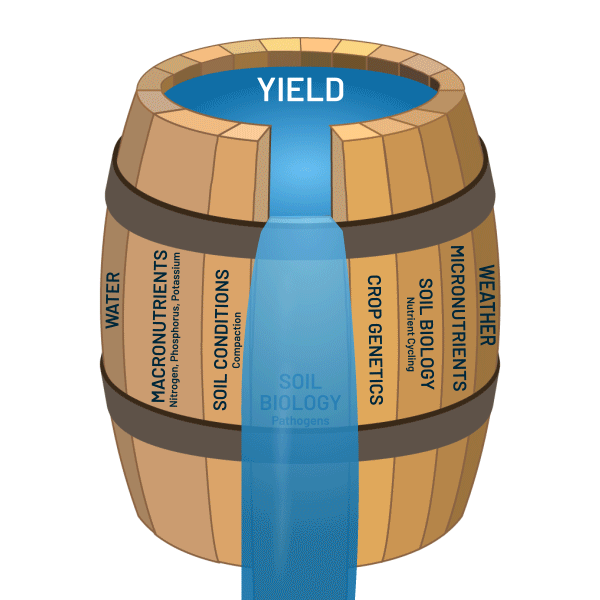Using Soil DNA to Better Understand Yield-Limiting Factors
In an ideal world, farmers would plant a seed in the ground, the seed would grow into a healthy plant, and the plant would produce the maximum output possible, be it grain, fruit, or vegetable. Throughout history, the process of domestication and breeding led to improvements in yield through crop genetics (1). As technology in agriculture has advanced through time, other limiting factors have been identified and addressed. Liebig’s Law of the Minimum tells us that the maximum crop yield is determined by the most limiting essential nutrient (2). In the early 1900s, the process for synthesizing nitrogen fertilizer was developed, and commercial production of other macro- and micronutrients followed (3). Today, the genetic potential of modern corn hybrids is over 600 bushels per acre (4), and growers can apply any nutrients that are lacking. With fertility and genetics research being well-established, what other limiting factors can be addressed with emerging technologies?
Developing technologies to address limiting factors has raised the height of staves in the barrel that depicts Liebig’s Law of the Minimum. (Image design inspired by UF/IFAS Communications.) With data from Trace Genomics, agronomists have the tools to address the limiting factors driven by soil biology.
Using 21st century technologies to manage pests
Historically, as limiting factors for crop yield have been identified, technology has been developed to address them. Synthetic fertilizers addressed nutrient deficiencies, and genetic limitations continue to be improved through advanced breeding techniques and biotechnology. Traditionally, the only available pest diagnostic tool has been to collect and submit soil or plant tissue to an analytical laboratory, generally only done after damage has occurred. While onset of a disease depends on environmental conditions, it would be most beneficial to have knowledge of a soil’s pest profile before seeds are planted. This information allows agronomists to make management decisions before disease has a chance to take hold. Trace Genomics offers the most comprehensive pathogen panel on the market, providing agronomists and crop advisors the tools to make informed decisions to tackle pests through seed selection, seed treatment, potential in-season treatments, and crop rotation.
Other diagnostic technologies may only identify a handful of pathogens or pests at a time, grouped into small packages. At Trace Genomics, we use metagenomics to sequence all soil DNA, testing for over 225 pests at once. While metagenomics technology began with a focus on bacteria and fungal pathogens, DNA from insects and nematodes can also be detected. In Fall 2023, Trace is expanding our list of reported pests by more than 50 species—including notable pests such as Soybean Cyst Nematode (SCN) and Western Corn Rootworm (CRW).
Comprehensive diagnostics from Trace Genomics
At Trace Genomics, our goal is to provide a thorough soil profile, so agronomists can identify their true limiting factor. Our flagship product TraceCOMPLETE™, includes a full suite of chemistry analytics in addition to revolutionary biological analysis: a list of over 225 pests covering more than 70 crop hosts, as well as biological nutrient cycling data. Actionable insights for pest management are provided in our Seed Solution Guide—an easy to understand summary of the pests in your soil presented alongside relevant chemistry data to help growers make the best management decisions. A full, quantitative list of detected pests can also be found in our interactive online platform, TraceVIEW.
Using insights presented in the Seed Solution Guide and on TraceVIEW, agronomists have more information than ever before to use for pathogen management recommendations.
- Seed selection based on tolerance to the most abundant or damaging identified pests is a strong first line of defense
- Seed treatment to provide protection against significant pests that may not be preventable using seed genetics
- In-season treatment plans can be budgeted in preparation for potential outbreaks to ensure all the tools needed to protect your crop are on-hand
- Crop rotation can be used to place a different crop with fewer or less damaging pathogens present, saving a susceptible host crop for a later year
In situations where in-season pesticide application is not feasible due to the proximity of fields to sensitive areas such as schools, nursing homes, hospitals, residential, or inaccessible areas, a good defense is often the best offense. Soil biological analysis through metagenomics provides a means for understanding what pathogens and pests are present before they have an opportunity to cause damage.
The comprehensive, actionable pest profile delivered with TraceCOMPLETE allows agronomists to make preventative management decisions such as seed selection, seed treatment, in-season treatment, and crop rotation.
About the authors: Dr. Tuesday Simmons is the Science Writer at Trace Genomics. She earned her Ph.D. in Microbiology from the University of California, Berkeley, studying the root microbiome of cereal crops. John Grandin is an agronomist with over 40 years of experience in the field. He is currently the Commercial Agronomist at Trace Genomics.
References:
- Vaughan, D.A., Balazs, E., and Heslop-Harrison, J.S. (2007). From Crop Domestication to Super-domestication. Annals of Botany 100, 893–901. https://doi.org/10.1093/aob/mcm224.
- Barak, P. (2000). Law of the Minimum. https://soilsfacstaff.cals.wisc.edu/facstaff/barak/soilscience326/lawofmin.htm.
- Appl, M. (1982). The Haber-Bosch Process and the Development of Chemical Engineering. In A Century of Chemical Engineering (Springer), pp. 29–54.
- Association, N.C.G. (2019). Records Broken in 2019 NCGA Corn Yield Contest. National Corn Growers Association. https://www.ncga.com/stay-informed/media/in-the-news/article/2019/12/records-broken-in-2019-ncga-corn-yield-contest.
- Savary, S., Willocquet, L., Pethybridge, S.J., Esker, P., McRoberts, N., and Nelson, A. (2019). The global burden of pathogens and pests on major food crops. Nature Ecology & Evolution 3, 430–439. https://doi.org/10.1038/s41559-018-0793-y.






